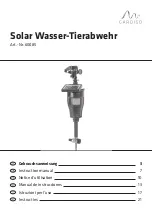
10
TROUBLE SHOOTING
DECREASE IN WATER FLOW
1. If you notice that your water flow is decreasing the most likely cause is that the filter needs to be backwashed. The bead filter is designed
to trap solids and does it very well. When fully loaded with solids, the filter may restrict flow. Perform a backwash and rinse.
2. If after backwashing the filter the water flow is still low, next check the strainer basket on the pump. Be sure that it is clean and replace.
3. If the flow is still low after cleaning your pre-filter and there was plenty of flow through the pump, then you need to inspect the internals
of the filter. Check to see if the laterals are clear of obstruction and that the beads are not caked into large clumps. When the bead pack
gets “gelled” they are hard to break apart with backwashing and doing a blower treatment. They may need to be manually broken apart.
When the beads are gelled they tend to cause “Channelling,” which means that the bead pack is totally clogged and water will follow
paths of little resistance through or around the bead pack. When Channelling is occurring you will notice that after backwashing the filter
quickly clogs and flow slows in intervals that used to take 1-2 weeks, now flow slows in 2-3 days. Follow the directions in the internal
inspection section of the filter operation section of the manual.
4. If you follow the above steps and your flow is still low, PLEASE call your dealer.
TROUBLE SHOOTING DECREASE IN WATER CLARITY
1. If your filter has a mature bacterial colony, which could take up to 4-6 weeks at temps. above 60-65 degrees F. (15-22º C), and your water
quality and clarity have been good then decrease, the first thing to do is a good backwash and rinse. Spend an extra amount of time with
the blower agitation of the beads.
2. If your clarity does not improve or improves then decreases quickly, open the filter and inspect the internal condition of the laterals and
the beads. If the beads are gelled and channelling is occurring, then the water will bypass most of the bead pack and no mechanical
filtration will occur. Manually break up the beads and make sure the laterals are clear of obstruction.
3. If your water clarity does not improve, and you have UV-lights on the system, check to see if the bulbs are still working. Depending on the
bulb, some UV-light bulbs will only have killing power for six months of continuous run. Others will last for a year or longer. Check to see
when they were last changed and replace if needed. They should be changed at least once a season.
4. If your clarity does not improve, check the water flow out of the system. The entire pond water volume should be turned over through the
filter system at least 3-4 times per day. If turn over time is slow then the amount of solids that the filter can capture will decrease. Check to
make sure that there are no flow restrictions. Follow the low flow trouble-shooting chart. Also make sure that your pump is large enough
to move the amount of water needed for enough turn overs through the filter.
5. If after following the above suggestions and the clarity has not improved, PLEASE call your dealer.
HIGH AMMONIA AND NITRITE WITH PREVIOUSLY STABLE STATE
If your pond has been up and running at warm temperatures (60-70 F or +/- 20º C) for six or more weeks and your ammonia and nitrite levels
have been previously controlled, but you experience a spike in the ammonia level try the following:
1. Perform an extra long blower treatment on the bead pack and an extra long backwash. If the bead pack becomes totally clogged with
solids, the available surface area for bioconversion drops significantly. Backwashing will open up the active surface area and bioconversion
will resume.
2. If after backwashing the ammonia levels are still high, open the filter. Check the laterals to make sure they are clear, stir the beads to break
up any gelled areas and then backwash.
3. If ammonia levels are still high, consider how much food is being fed to the fish. One cubic foot of mature beads can handle around one
pound of 35% protein food per day. Check to see how many cubic feet of beads are in your filter and compare that with the amount of food
you are feeding.
4. If ammonia levels are still high, check the flow rate through the filter. The entire volume of the pond should be turned over through the
filter AT LEAST 3-4 times per day. If the flow is down for some reason, bioconversion of ammonia will also slow. If you find the flow is in fact
down, follow the troubleshooting flow chart for correcting low flows.
5. If all the above are found to be in good condition, consider the fish load on the pond. This actually also relates to the above discussion
about amount of food fed. If you have a heavily stocked pond you will also be feeding more to the fish and thus adding more nitrogen to
the pond water that will have to be bio converted. Again, consider your filter size and what you are asking it to do.
6. If the ammonia levels are still high, call your dealer.











































